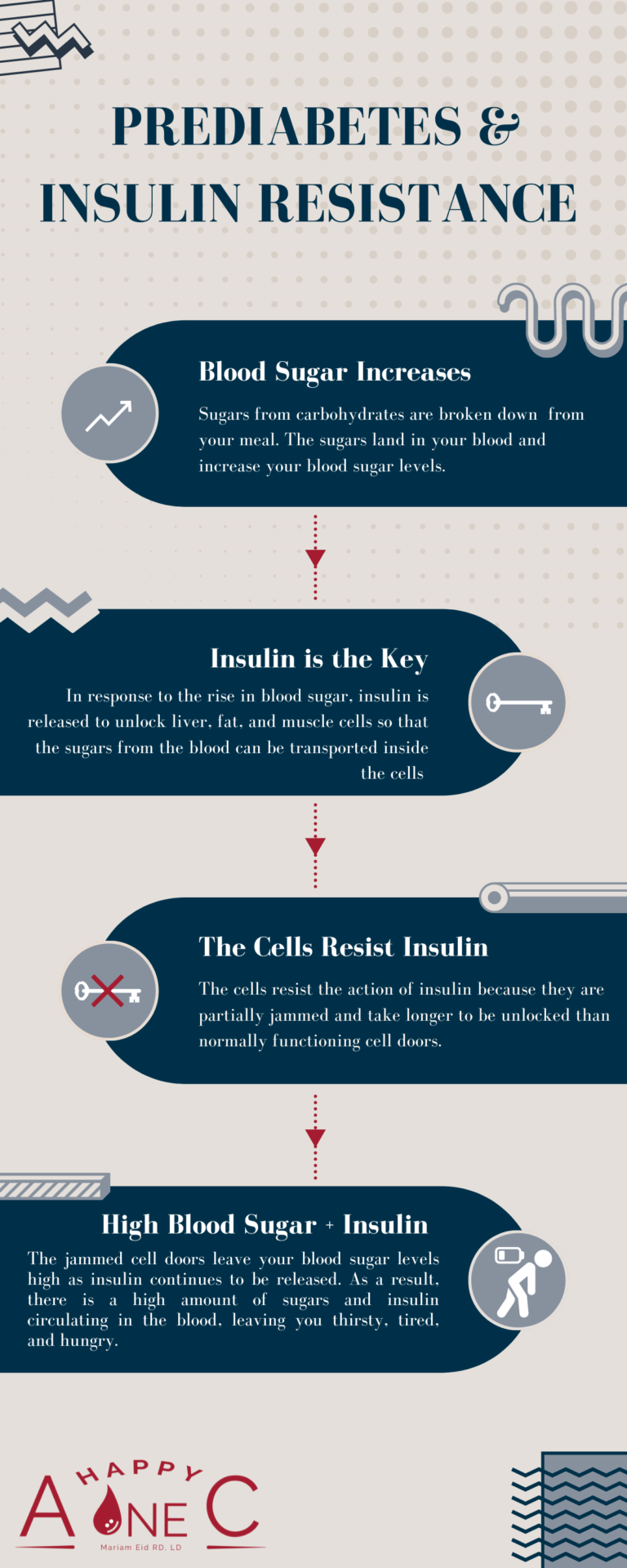Prediabetes is a condition where blood sugar levels are elevated beyond normal levels but not yet considered Diabetes. Insulin resistance is the main driver of prediabetes and is responsible for many of the symptoms associated with prediabetes. These symptoms include mood swings, urination at night, feeling extra thirsty, blurry vision, slowed healing, fatigue, tingling in hands/feet, hunger, frequent UTIs, and dark patch (or band) of velvety skin on the back of your neck, armpit, or groin. Talk to your doctor if you suspect you may be at risk.
Insulin resistance
To understand insulin resistance, it’s important to first define blood sugar and insulin.
Blood sugar refers to the amount of sugar concentrated in the blood. We need a certain amount of sugar in the blood to keep our physiological processes running.
Insulin is a hormone made by the pancreas responsible for lowering blood sugar levels when they become elevated. It is the key your cells require to unlock them and allow the flow of glucose from the diet into the cell. The sugars in the bloodstream come from carbohydrates in our meals. During digestion, the sugars are reoriented to the shape of glucose because that’s the shape preferred by the body.
Insulin is a hormone made by the pancreas responsible for lowering blood sugar levels when they become elevated. It is the key your cells require to unlock them and allow the flow of glucose from the diet into the cell. The sugars in the bloodstream come from carbohydrates in our meals. During digestion, the sugars are reoriented to the shape of glucose because that’s the shape preferred by the body.
When glucose enters the blood, our blood sugar levels increase. The high blood sugar levels alert the pancreas to let out insulin so it can unlock the cells, promote the flow of sugars into the cell, and lower your blood sugar. Since glucose is our body’s preferred source of energy, this process also delivers glucose to your cells so that they can produce energy and we can continue to perform daily tasks of living.
Insulin resistance occurs when there is abnormality in insulin’s ability to unlock the cell doors. The cells resist the action of insulin because they are partially jammed and take longer to be unlocked than normally functioning cell doors. Insulin is being prevented by the cell to do its job efficiently. The more sugars eaten at that meal, the more sugars there are waiting in line to enter the poorly functioning cell doors. The jammed cell doors leave your blood sugar levels elevated and insulin continues to be released by the pancreas. As a result, there is a high amount of sugars and insulin circulating in the blood. The state of high blood sugar is called Hyperglycemia and the state of high insulin levels is called Hyperinsulinemia. The video above explains how insulin resistance mechanism in its more severe form when it progresses to Type 2 Diabetes. Insulin resistance with prediabetes occurs at a lower level than diabetes.

Hypoglycemia and hyperglycemia
With prediabetes and earlier stages of type 2 diabetes, the cell doors eventually unlock to enter liver, muscle, and fat cells, but take a longer time to do so. Insulin ends up being released in excess because of the initial cell door jamming. As a result, insulin may linger in the bloodstream AFTER your blood sugar levels decrease and return to normal. This means that the leftover insulin in the blood will continue to do its job and further decrease blood sugar levels. This is problematic because low blood sugar, or hypoglycemia, is more deadly than high blood sugar. The body typically alerts you when this happens by making you feel irritable, nauseated, tired, hungry, dizzy, shaky and in extreme cases, you may lose consciousness.
We want to avoid both low and high blood sugar levels. The goal is to be in the happy medium. The state of chronic hyperglycemia is what characterizes the prediabetes and diabetes diagnoses. Since there are more sugar molecules in the blood stream, they attach to the protein structure, hemoglobin, in the blood and reflect a high A1C reading.
High blood sugar levels are toxic to the blood stream if left untreated over long periods of time. It makes your blood stickier and thicker, similar to the consistency of syrup or honey. This increases the work your heart and kidneys have to do to pump and filter the blood in your body. That’s why, with prediabetes, you are at risk for later developing not only Type 2 Diabetes, but also heart and kidney disease.
Insulin Sensitivity
Insulin sensitivity refers to the idea of sensitizing your cells to the action of insulin. In working towards reversing insulin resistance, we aim to enhance insulin sensitivity. Insulin resistance is a state of poor insulin sensitivity because the body rejects the action of insulin. The more sensitive your cells are to insulin, the better controlled your blood sugar levels are. Therefore, the goal with managing and reversing prediabetes is to increase you cell’s insulin sensitivity.
To learn about food and nutrition strategies to increase insulin sensitivity and explore how food affects your blood sugar, click here.
